|
हरिश्चंद्र इंद्रवज्र |
|
Harishchandra Spectre |
|
June 2013 |
|
Please use minimum 1280 pixel horizontal screen
resolution for viewing. Please be patient while all the images in
webpage are loaded. |
|
Please do not use the images for any commercial
use without permission. Text in Marathi and English is not exact
translation. |
|
|
|
|
आभाळात दिसणारे इंद्रधनुष्य न पाहिलेला माणुस शोधुन सुद्धा सापडणार नाही. इंद्रधनुष्याच्या रंगात असणारी किमया सर्वांच्या मनात आनंदाचा तरंग फुलवते. पावसाळ्यात आपल्या एका बाजुला सुर्य व दुसऱ्या बाजुस पाउस अशी स्थिती झाल्यास क्वचित इंद्रधनुष्य दिसते. इंद्रधनुष्य हे पाण्याच्या लहान थेंबात होणाऱ्या प्रकाशाच्या परावर्तन व वक्रिभवन यामुळे दिसते. सफेद रंग या प्रक्रियेत ७ रंगात विभागला जातो. त्यांच्या तरंग लांबीतल्या फरकामुळे आपल्याला लाल ते जांभळा असे रंगाचे पट्टे दिसतात. इंद्रधनुष्या सारखीच पण दिसण्यास वेगळी अशी अजुन एक किमया आहे ज्याचे नाव आहे इंद्रवज्र. इंद्रवज्र संपुर्ण गोल दिसते. त्यात ३ किंवा अधिक रंगीत पट्ट्यांचे संच दिसतात. आकाराने लहान असले तरी ते पाहिल्यावर पाहणारा अचंभित होतो. उंच पहाडावर विशिष्ठ परिस्थिती जुळुन आल्यास इंद्रवज्र दिसते. देवाच्या डोक्याभोवती कल्पित प्रभाचक्रा प्रमाणे ते भासते. इंद्रवज्रात फक्त रंगच दिसत नाहीत. त्यात आपल्याला आपली सावली मध्यभागी दिसते. आपल्या सावली भोवती दिसणाऱ्या या प्रभे मुळे आपण देवासमान असल्याचा पाहणाऱ्यास आभास होतो. देव दुसरा कोणी नसुन आपल्यातील चांगल्या प्रवृत्तींचा सारांश आहे असे मन समजते. शास्त्रीय दृष्टिकोन असणाऱ्यास इंद्रवज्र एक गमतीदार पण गहन कोडे वाटते.
|
|
The expedition to see and photograph the circular rainbow (Indravajra) in Western Ghats took us to Konkan cliff of Harishchandragad. Being one of the geological wonders of Western Ghats, the cliff has amazing structure. It is a vertical precipice with overhang. The overhang is about 10 meters. The height is 3900 feet (1300 meters) above msl. There is a semicircular valley on the western end of the mountain having vertical fall depth of 1200 feet. The horizontal arc length of the cliff top edge is about 1 km. In the pre and post monsoon season, a strange natural phenomenon called as glory or circular rainbow can be seen from this cliff edge. The phenomenon is similar to rainbow. However its scientific principle and structure is entirely different from that of rainbow. The normal rainbow is called as “Indradhanushya” in Marathi. The glory or circular rainbow is called as “Indravajra” in Marathi. In western world the spectacle is named the “spectre of the Brocken” after the peak in the Harz Mountains of Germany, where it is often seen. We will refer it as “Indravajra” in this article here onwards.
|
|
|
| |
 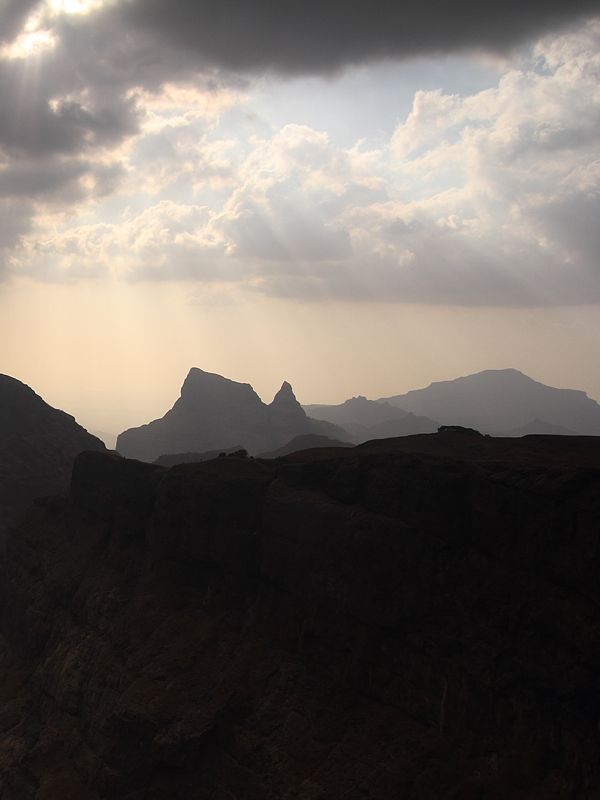 |
| |
| Afternoon Cumulus clouds, Harishchandragad, North western ghats, India
|
| |
|
|
इंद्रवज्र इंद्रधनुष्यापेक्षा बऱ्याच बाबतीत वेगळे असल्यामुळे हे कोडे कुतुहलात रुपांतरित होते. पावसाळ्या आधी आपल्याकडे पुण्यात आभाळ निरभ्र असते. मात्र मे महिन्याच्या शेवटी सह्याद्रीच्या डोंगर रांगात कोकणातुन रोज संध्याकाळी ढगांची नवी फौज घाटमाथ्यावर चढते. याला इंग्रजीत व्हर्टिकल क्लाउड बर्स्ट असे म्हणतात. या ढगांमुळे बऱ्याचदा वळवाचा पाऊस घाटावर पडतो. उसळणारे मेघ दुसऱ्या दिवशी मध्यान्ही पर्यंत दिसतात.
|
|
Normal Rainbow : One will find hardly a person who has never admired a rainbow. From ancient times the beauty of rainbow has always made a striking impression on observers. It is considered as a good sign and omen in many cultures. The magical impression that the rainbow creates is hardly replicated by any other optical event in the nature. |
|
|
| |
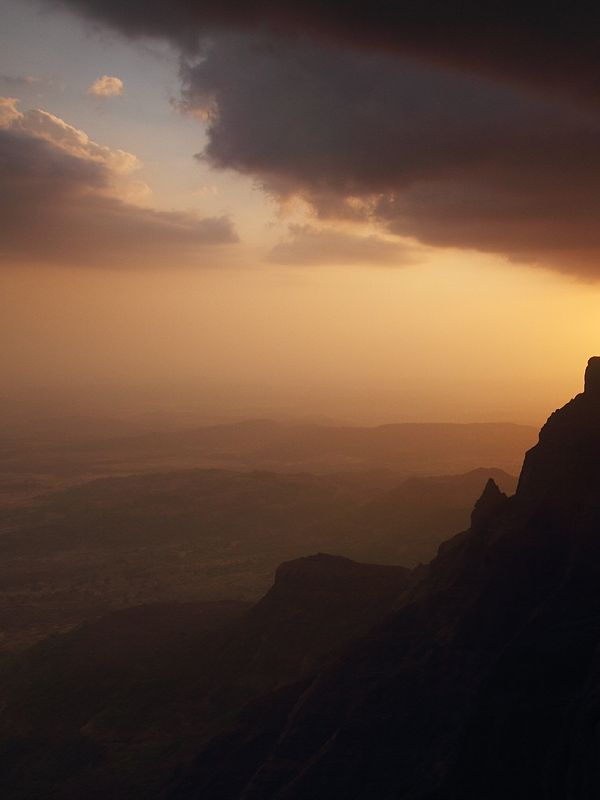  |
| |
| Evening sunset under the thunderstorm clouds, Harishchandragad, North western ghats, India
|
| |
|
|
| |
  |
| |
| Morning white could screen in valley before sunrise, Harishchandragad, North western ghats, India
|
| |
|
|
दुपारनंतर नंतर दरी रिकामी होते. सकाळच्या या मेघ पटलावर पुर्वेकडुन सुर्यप्रकाश पडताच इंद्रवज्र दिसते. दरित ढग असताना घाट्माथ्यावर मात्र ढग असता कामा नाहीत. घाटमाथ्यावर जर ढग असतील तर ते सुर्यप्रकाशास मेघ पटलावर पोहोचुन देत नाहीत. मुसंडी मारणाऱ्या ढगांच्या मध्ये अधुन मधुन मोकळीक होते. त्याच्या मुळे दरित ढग पण माथ्यावर नाहीत अशी स्थिति अधुन मधुन निर्माण होते. या काळात इंद्रवज्र दिसते. हरिश्चंद्र गडाच्या कोकण कड्यावर असलेली भौगोलिक परिस्थिती यास अनुकुल आहे.
|
|
Now we know that it is not a magic but an optical phenomenon connected with the refraction of the light in floating rain drops in air. Rainbow can be only observed with one’s back towards the sun with sun shining on the veil of rain. The colors of rainbow appear in a sequence, violet at lower end, and upper end is red. Secondary rainbow appears in a reverse order outside the primary rainbow.
|
|
|
| |
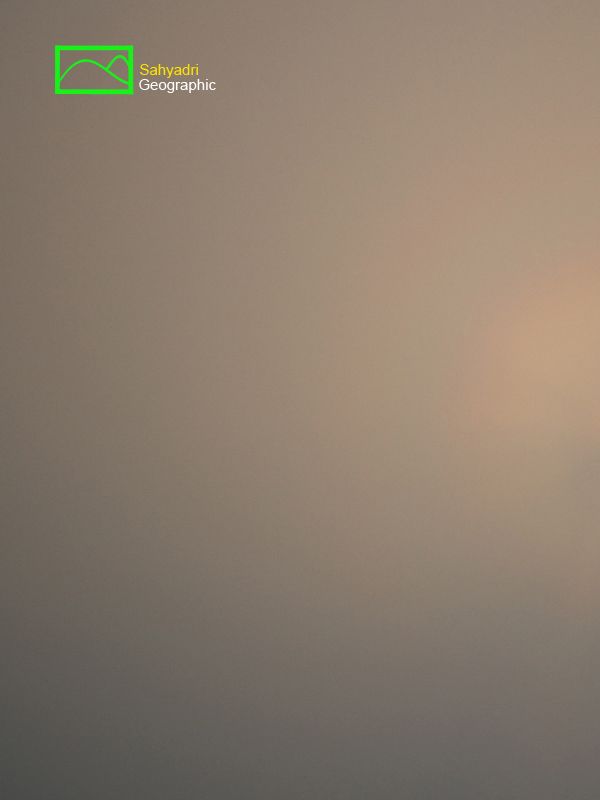 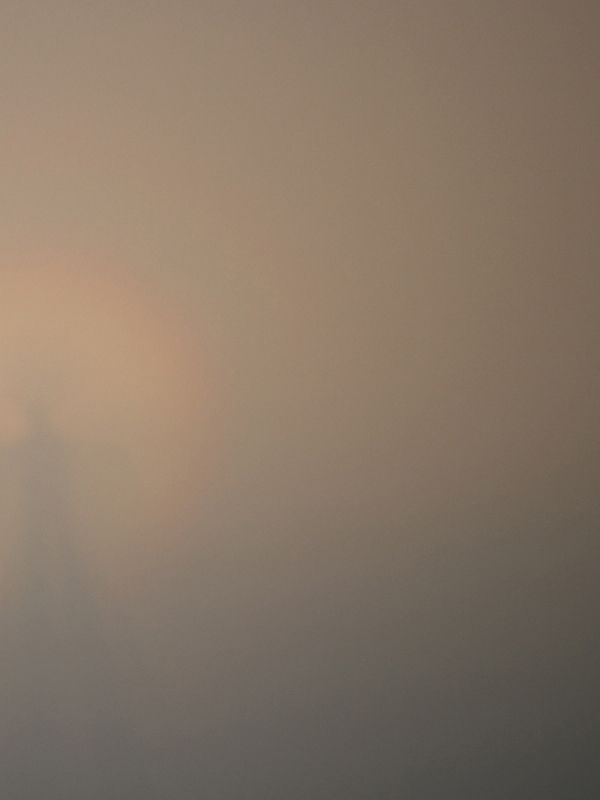 |
| |
| Faint Indravajra immediately after sunrise showing the large shadow, Harishchandragad, North western ghats, India
|
| |
|
|
मे महिन्याच्या अखेर सुर्य ६६ अंश उत्तर पुर्व दिशेस उगवतो. नेमक्या याच कारणामुळे सुर्य उगवतीच्या वेळेस सुद्धा कड्याच्या मध्यावरुन पुर्वेस दिसतो. उंच पर्वत रांगात अशी स्थिती दुर्मिळ होय. तारामती शिखराच्या उतारामागे तो दडत नाही. जर सुर्य ७० पेक्षा जास्त उत्तर पुर्व कोनात उगवला तर तो सुर्योदयाच्या वेळेला तारमतीच्या मागे दडतो. अशा स्थितीत इंद्रवज्र भल्या सकाळी दिसले नसते. पावसाळ्याच्या शेवटी सप्टेंबरच्या वळवात, हा कोन ९० अंश असतो. त्या वेळेस सुर्योदयानंतर लगेच कड्याच्या मध्य भागातुन इंद्रवज्र दिसत नाही. त्यामुळे तारामतीच्या मागे दडलेल्या सुर्यास बाहेर पडे पर्यंत वाट पहावी लागते.
|
|
. Rainbow is seen when the sun is at elevation less than 42 degree. The sunlight refraction and reflection in the water droplet leads to the splitting of white lightrays in to various colored rays due to the difference between the wavelengths for each color.
Indravajra is similar but a distinct phenomenon. It is different to the rainbow in many aspects. Indravajra is a rather mysterious phenomenon. During the expedition, evaluation was done to understand what parameters affect and help in generating this interesting phenomenon at this specific location.
|
|
|
| |
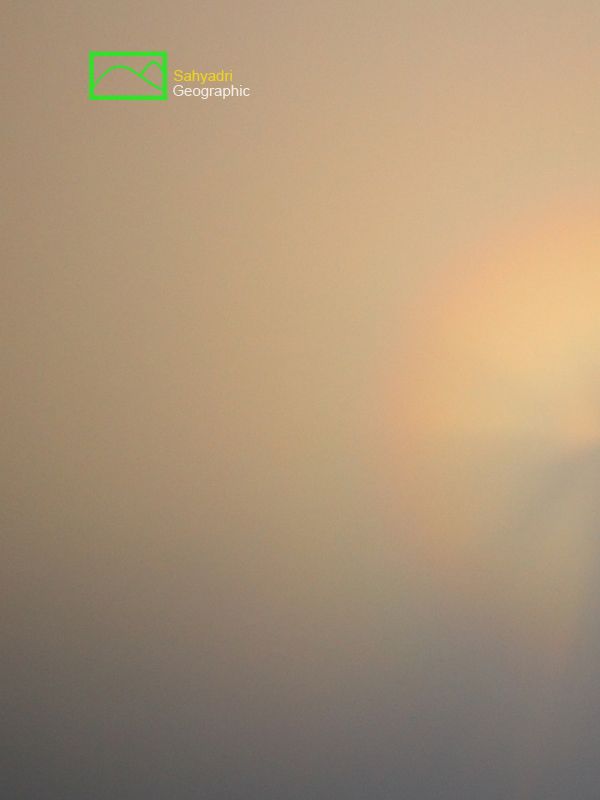 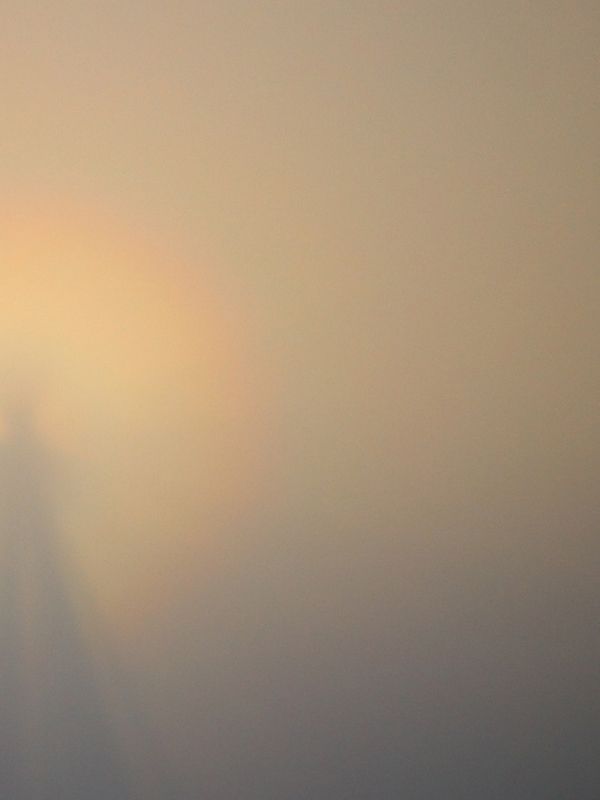 |
| |
| Faint Indravajra immediately after sunrise showing the large shadow, Harishchandragad, North western ghats, India
|
| |
|
|
इसवीसन १८३५ साली कर्नल साइक्स नावाच्या निपुण इंग्रज अधिकाऱ्याने, कोकण कड्यावरुन इंद्रवज्र पाहिले याचा उल्लेख सरकारी दफ्तरी आढळतो. साइक्सने आपल्या कारकिर्दित सह्याद्रीचे बरेच किल्ले व डोंगरमाथे पाहिले. त्याने येथील पक्षी, प्राणी, हवामान, भुगोल, भुशास्त्र, लेणी, माणस, त्यांच्या प्रथा, धर्म अशा अनेक विषयांचा सखोल अभ्यास केला होता. या विषयांवर त्याने बरेच लेख व शोधनिबंध लिहिले होते. त्याच्या भुगोल व हवामान या विषयाच्या अभ्यासामुळेच तो इंद्रवज्र शोधत कोकणकड़्यावर पोहोचला.
त्याला इंद्रवज्र दिसणे हा योगायोग नव्हे. त्याने येथील ढगांच्या हालचालींबद्दल तंतोतंत निरिक्षणे आपल्या लेखांमध्ये नमुद केली आहेत हे वाचुन मला आश्चर्य वाटले. त्याला ते महात्मा गौतम बुद्धाच्या प्रभाचक्रासारखे वाटले. या माणसाचा बुद्ध धर्माचा गाढ अभ्यास होता.
|
|
Indravajra occurs when the, observer stand at the edge of the cliff. The valley on western side of the cliff top is full of clouds rising high from lower konkan plateau. Due to semicircular valley entrapment, it has stagnant collection of fog or clouds even in the premonsoon dry season. The valley gets filled with clouds formed due to condensation in evening and night after sunset. These clouds simulate a white screen in this valley and above it. Due to shape of the cliff, the vertically surging clouds often extend above the valley for about 15 to 20 meters. Early morning when the sun rises behind the viewer on eastern horizon, the sunlight falls on the cloud screen in the valley. If the viewer stands between the sun and valley at the edge of the cliff, viewer sees his own shadow in the valley with circles of colors around him.
|
|
|
| |
 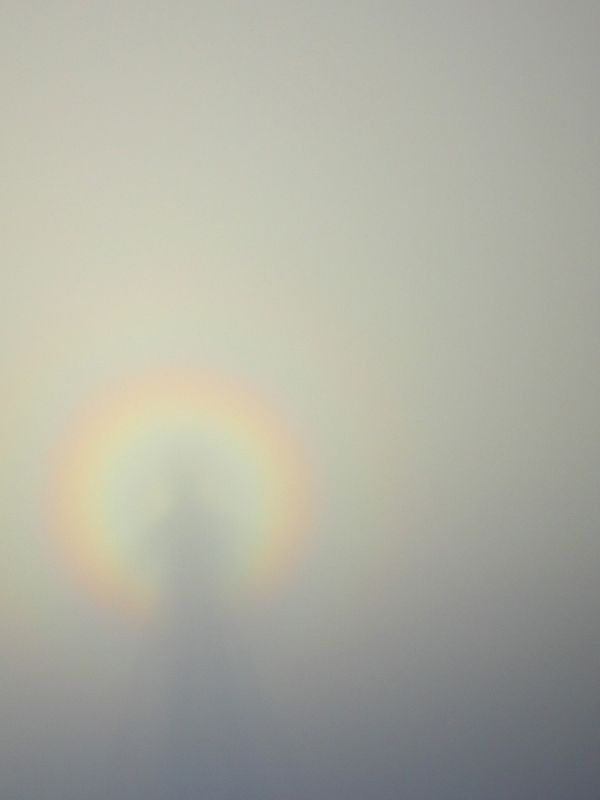 |
| |
| Faint Indravajra at distance , Harishchandragad, North western ghats, India
|
| |
|
|
ढगातील पाण्याचे थेंब अंदाजे १० ते २५ मायक्रॉन असतात. अशा थेंबांमधुन सुर्यप्रकाशाचे परावर्तन, बहु वक्रिभवन, विवर्तन, अनुस्पंदन व व्यतिकरणामुळे इंद्रवज्र दिसते. इंद्रधनुष्यापेक्षा याचे निर्मिती तत्व हे वेगळे व किचकट आहे. या विषयावर अजुन अभ्यास सुरु आहे.
|
|
Often 3 or more color bands are seen around the shadow. The phenomenon is seen intermittently due to change in conditions. The clouds in valley, clear sunlight with no clouds on eastern side, are must for the phenomenon to occur.
|
|
|
| |
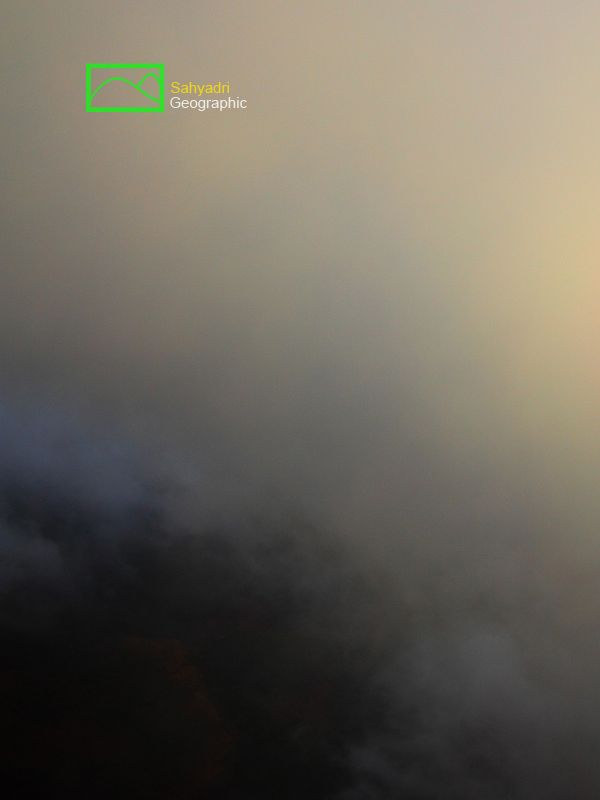 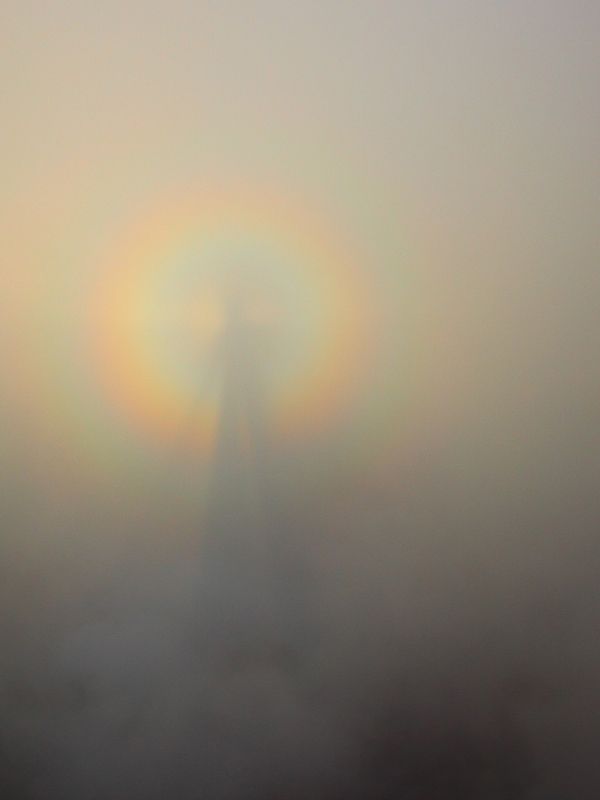 |
| |
| Faint Indravajra with valley below, Harishchandragad, North western ghats, India
|
| |
|
|
हरिश्चंद्रगड कोकण कड्याच्या माथ्यावरुन इंद्रवज्र दिसण्यास तेथील भौगोलिक परिश्थिती कारणीभुत आहे. योग्य प्रमाणातील हवामान व सौर्य स्थितिमुळे ते तेथे सहज दिसते. म्हणुनच कदाचित पुरातन काळापासुन येथे आध्यात्मिक स्थळ निर्माण झाले असावे. झंज राजाने येथे अत्यंत सुंदर शिवालय निर्माण केले आहे.
|
|
The cliff has high altitude. Sun can be seen immediately after sunrise time (10 minutes later), as there are no hills higher than the hill on eastern side (66 degree wrt north). The sun rises in last week of May, first week of June at around 66 degree east wrt north. This coincidence helps the viewer to see the phenomenon. Had the sun position been more than 66 degree, the view would have been obscured at sunrise.
|
|
|
| |
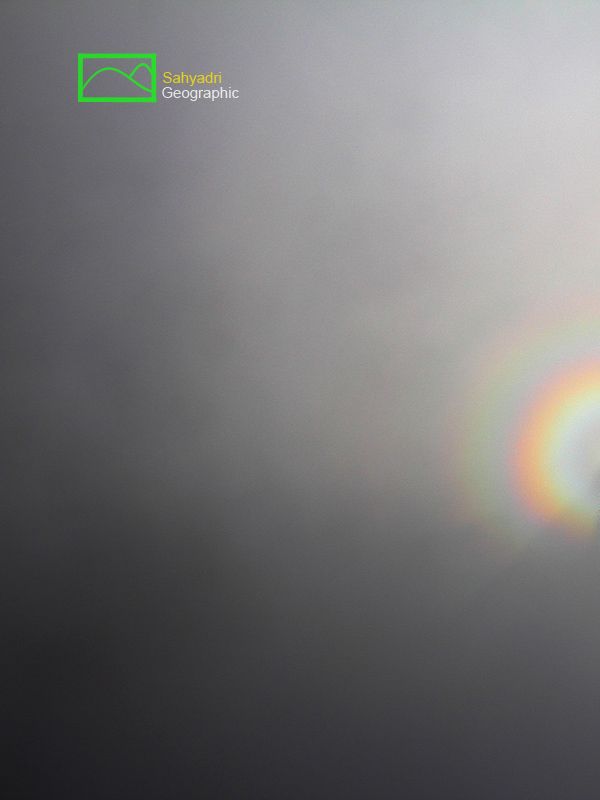  |
| |
| Indravajra at a distance with bright sun , Harishchandragad, North western ghats, India
|
| |
|
|
इंद्रवज्र पहाताना ते ढगांच्या हालचालींमुळे कधी कधी आपल्याकडे वेगाने येताना दिसते. तर ते कधी दुर हटते. त्याच बरोबर त्याचा आकार बदलतो. ५ ते २० अंश कोनात ते दिसते. सुर्यप्रकाश प्रखर असल्यास ते स्पष्ट दिसते. त्याचे रंग खुलतात. अंधाऱ्या खोल दरित दिसल्यास ते अजुन छान दिसते. प्रत्येकास फक्त स्वत:चीच सावली इंद्रवज्रामध्ये दिसते. योग्य सावली पहाण्यास स्थिर रहाणे महत्वाचे आहे. एकमेकांपासुन अंतर ठेवल्यास स्पष्टता वाढते. आपण केलेली हालचाल आपल्यास सावलीत दिसते. सावली आपलीच आहे हे त्यामुळे स्पष्ट होते. ढग तुरळक असल्यास दरित इंद्रवज्राबरोबर जमिन दिसते.
|
|
The view would have been still possible but after some time gap after sunrise (1 hour or so), and not at sunrise. This does not mean that the phenomenon is seen only at this cliff. There are many such high rise mountains in Western Ghats with semicircular entrapment valleys and no major mountain on eastern end. The north western ghat is typically oriented north-south with valley on west and dry region on east. Hence in this region Indravajra is seen in morning and not in evening.
The Indravajra can also be seen from aircrafts, surrounding its shadow on the clouds below. The physical origin of the Indravajra was an optical mystery until the recent times, when it was calculated correctly by scattering theory.
|
|
|
| |
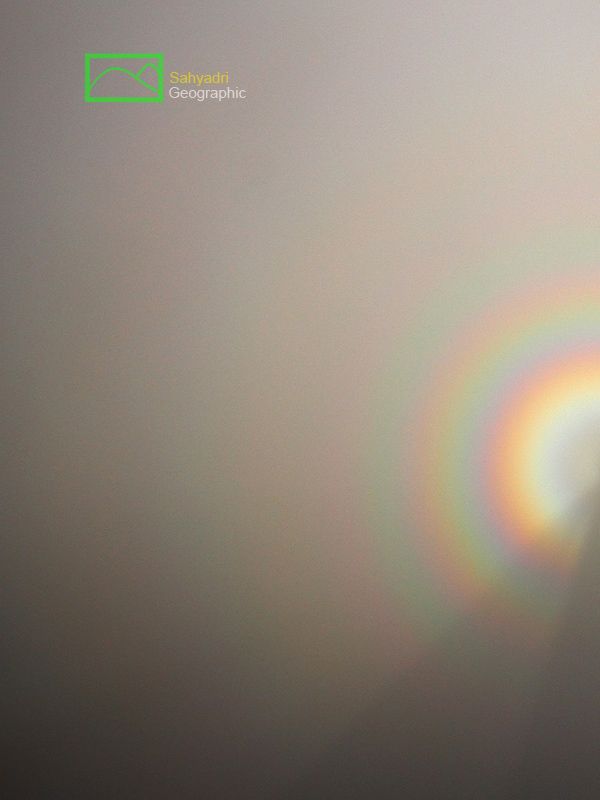 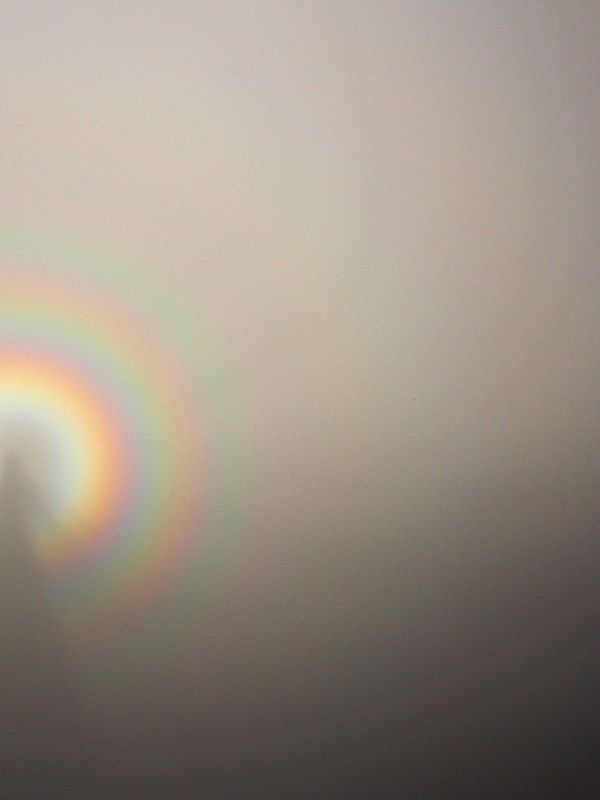 |
| |
| Indravajra at a close distance with bright sun , Harishchandragad, North western ghats, India
|
| |
|
|
रात्रीच्या वेळेस मुसंडी मारणाऱ्या ढगांवर विजेरीने आपणास सावली पहाता येते. मात्र त्याभोवती प्रभा दिसत नाही.
अशा या किमयेचे शास्त्रीय स्पष्टीकरण माहित असले तरि याचे दुर्मिळ दर्शन मनास मंत्रमुग्ध करते. कुतुहल निर्माण करते. आपल्यातला देव जागवते. नवचैतन्य निर्माण करते.
|
|
The small water drops of clouds and fog produce it; however, no intuitive physical explanation is available. In part the glory comes from light guided by the interface of water and air (surface waves) and in part from light that undergoes many internal reflections. (Please read the left and right column for english after next image)
|
|
|
| |
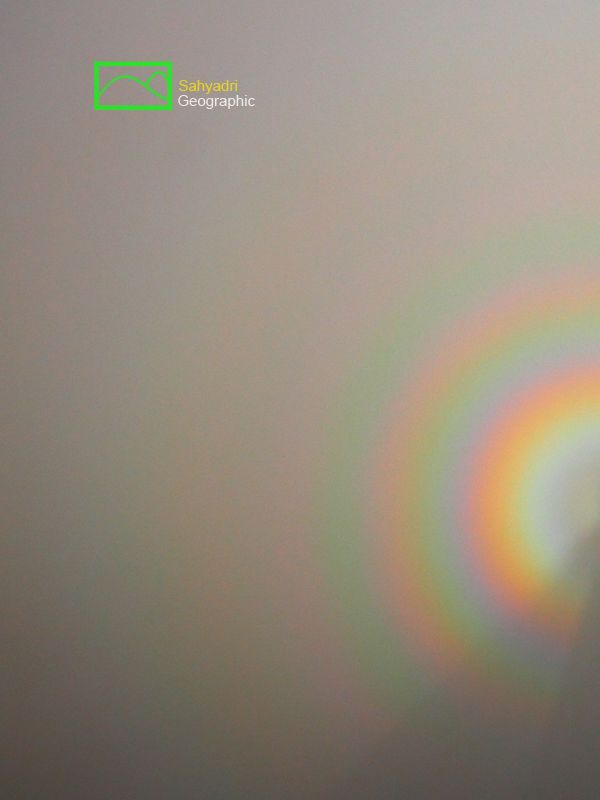 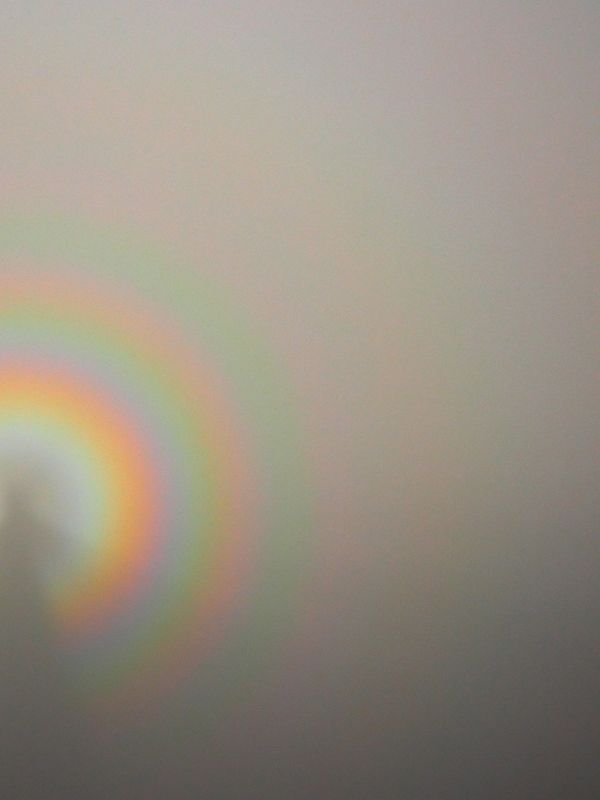 |
| |
| Indravajra at a very close distance with bright sun , Harishchandragad, North western ghats, India
|
| |
|
|
It has a bright centre. Its rings are delicately colored. Blue on the inside changing through greens to red and purple outside. The ring intensities fall off much more slowly and sometimes three or even four rings are visible.
Light scattering contains many effect such as diffraction, interference, resonance (multiple reflection). Mie scattering has some peaks in the backward, as the result, we can watch sometimes more than 3 rings. The angular size is much smaller than a rainbow, about 5° to 20°, depending on the size of the droplets. The glory can only be seen when the observer is directly between the sun and cloud of refracting water droplets. The typical size of water drops in cloud is about 10-25 microns. Depending on the size of the water drops, the intensity and number of rings vary.
|
|
The Gazetter of Ahemednagar District has records about the event from 19th Century British Surveys. The col. Sykes after his victorious attacks on various Forts in western ghats in Maharashtra, acted as a specialists for British East India Company to investigate in to various social, geological, geographical, mythological, archaeological, spiritual, zoological and meteorological surveys of deccan plateau and western ghats. In his last days of tenure he landed on Harishchandragad for the ornithological survey. During one such mission he encountered the circular rainbow or Harishchandra Spectre (Indravajra). He was a good friend of Darwin, due to his contributions to the ornithology (Birds zoology). Ahemedanagar Gazetter has following record about his observations.
|
|
|
| |
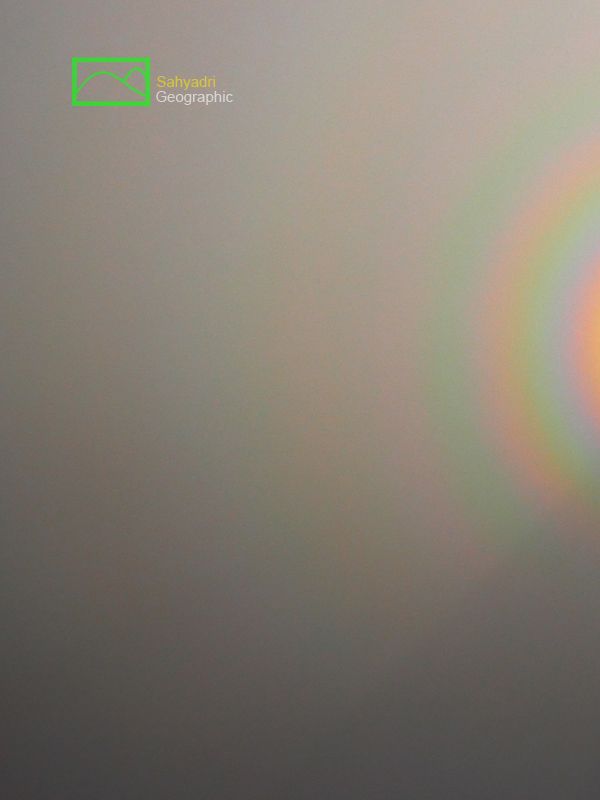 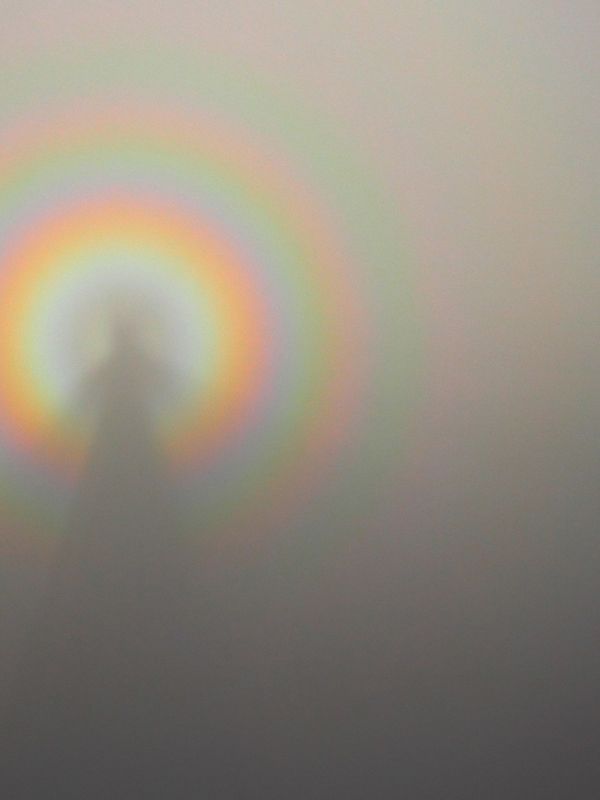 |
| |
| Indravajra at a very close distance with bright sun , Harishchandragad, North western ghats, India
|
| |
|
|
“Especially in May the edge of the Konkan cliff often gives an excellent view of the curious phenomenon called the Circular Rainbow. In 1835 Colonel Sykes during periods of fogs and mists several times observed the circular rainbow which from its rareness is spoken of only as a possibility. Sometimes the Konkan fog stratum rose somewhat above the level of the top of the Harishchandragad cliff, without coming over the table-land. Colonel Sykes stood at the edge of the precipice just outside of the limits of the fog, with a low cloudless sun on his back. The circular rainbow appeared perfect and most vividly colored, one-half above Colonel Sykes' level and the other half below. Distinct outline shadows of Colonel Sykes, his horse and his men appeared in the centre of the circle as a picture to which the bow served as a resplendent frame. [ Colonel Sykes' men could not believe that the figures they saw were their own shadows and assured themselves by tossing about their arms and legs and putting their bodies in various postures] From their nearness to the fog the diameter of the rainbow circle never exceeded fifty or sixty
|
|
feet. Accompanying the brilliant rainbow circle was the usual outer bow in fainter colors. The Fokiang or Glory of Buddha as seen from mount O in West China tallies more exactly with the phenomenon than Colonel Sykes' description would seem to show. Round the head of the shadow always appears a bright disc or glory, and concentric with this disc, but separated by an interval, is the circular rainbow. The size and brilliancy of the rainbow varies much with the distance of the mist; when the mist is close the diameter may not be more than six feet. Whether the observer sees only his own shadow or the shadow of others with him depends on the size of the rainbow. Each observer always sees the head of his own shadow in the centre of the glory. Their rings are delicately colored like those of the corona's, blue on the inside changing through greens to red and purple outside. The ring intensities fall off much more slowly than those of the corona and sometimes three or even four rings are visible.
|
|
|
| |
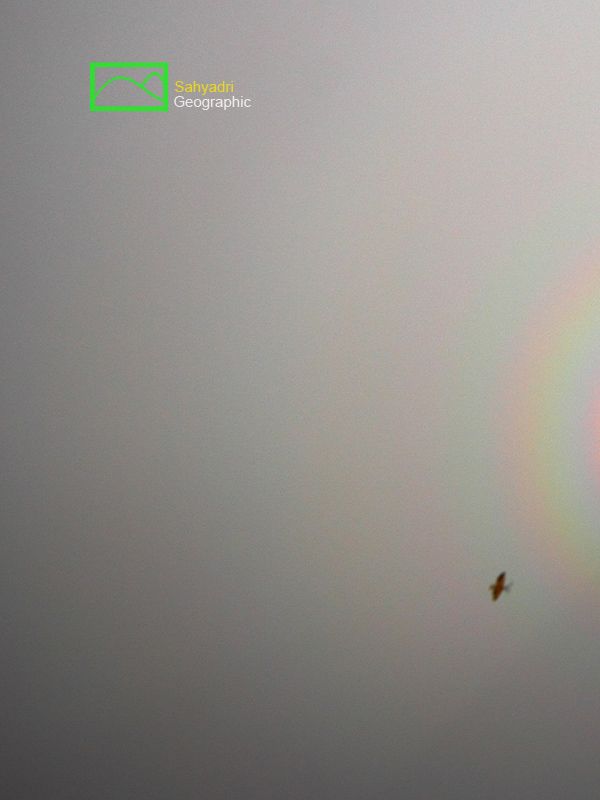 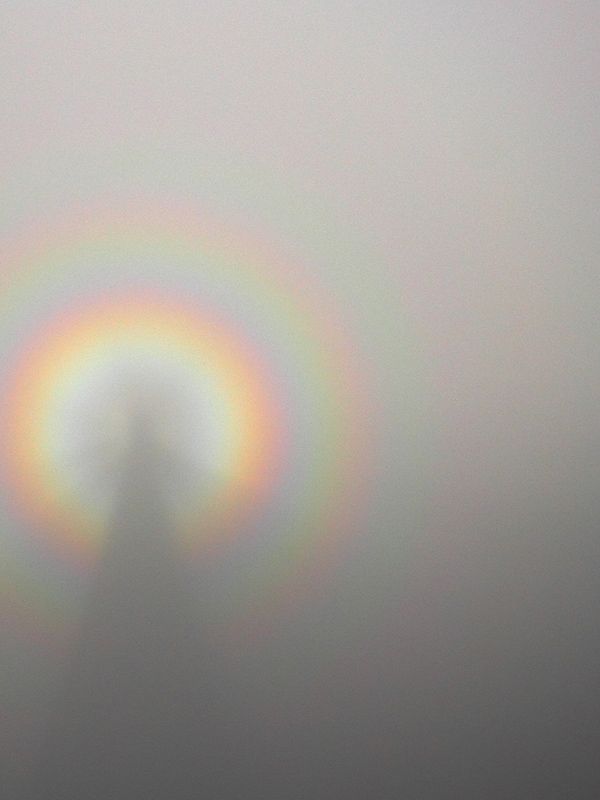 |
| |
| Indravajra at a very close distance with bright sun with a swift passing by , Harishchandragad, North western ghats, India
|
| |
|
|
Prabhashvara is the color of the aura of Gautam Buddha. The actual spectrum of his aura consists of five colors, blue, yellow, crimson, white and scarlet. The mixture of those five colors is believed to be Prabhashvara but it is depicted as separate straps of the five colors. The rainbow body phenomenon is a third person perspective of someone else attaining complete knowledge. Knowledge is the absence of delusion regarding the display of the basis.
|
|
In China, this phenomenon is called Buddha’s light. It was often observed on cloud-shrouded high mountains, such as Huangshan Mountains and Mount Emei. Records of the phenomenon at Mount Emei date back to A.D. 63. The colorful halo always surrounds the observer's own shadow, and thus was often taken to show the observer's personal enlightenment (associated with Buddha or divinity).
|
|
|
| |
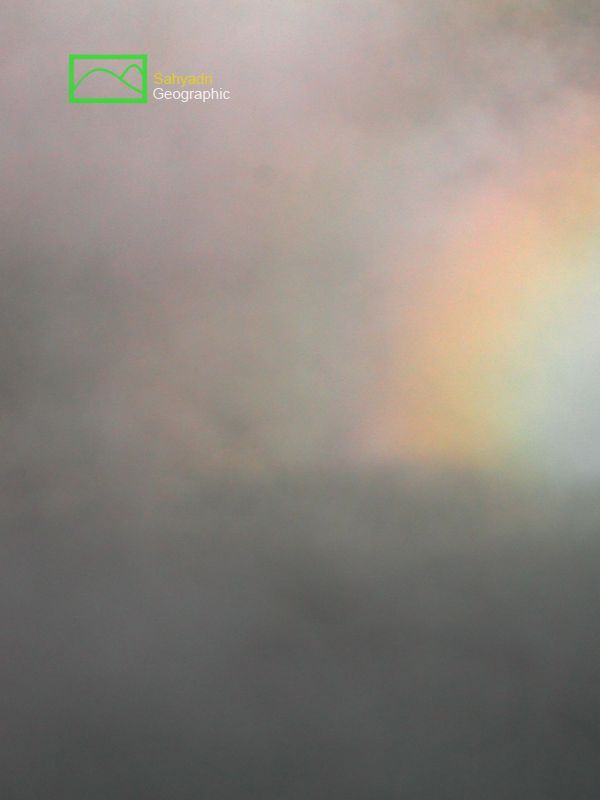 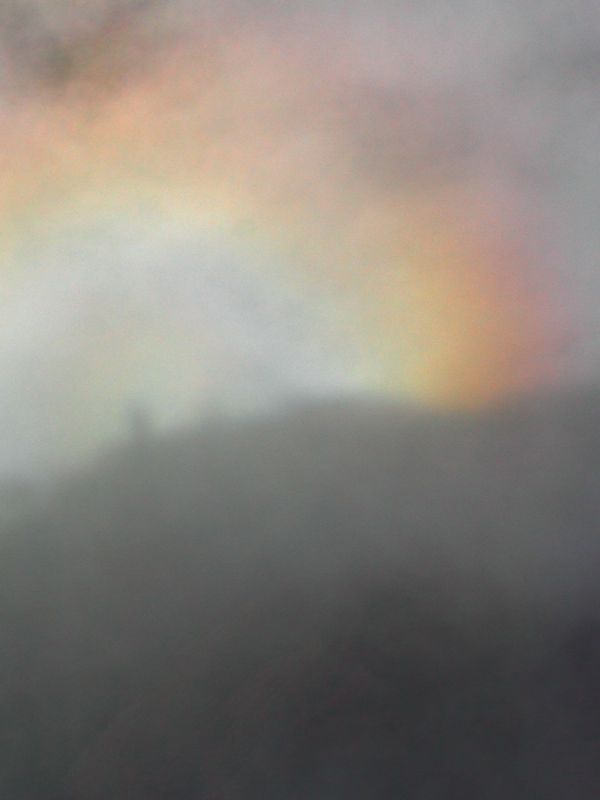 |
| |
| Indravajra at a very far distance with bright sun with less clouds, Harishchandragad, North western ghats, India
|
| |
|
|
The various factors that favor Indravajra sighting at Harishchandragad are –
a) The weather should be clear, as shown in satellite image. The dry weather helps to keep eastern side of the cliff clear of any clouds. This indirectly allows sunlight to reach up to the clouds in valley. A thunderstorm on earlier day helps the clear eastern weather in the morning. Hence the visibility of Indravajra is linked to Thunderstorm season before and after monsoon. Typically in 2013, due to small cyclones on either side of India, namely in Oman and Bengal, lead to disturbed weather with high wind speeds during 20th May to 29th May. On 30th May both these UACs faded away allowing thunderstorm trough to reach north Western Ghats and Konkan. The thunderstorm season started on 29th May. Kumshet area near Harishchandragad received the
|
|
first thunderstorm of region on 29th May. This beginning of thunderstorm season allowed the visibility of Indravajra with ease from 31st May onwards.
b) In end May and early June, the sun rises in north east direction. The azimuth angle is 66 degree wrt north. This allows the sunrays to reach exactly the center section of cliff and valley without getting obstructed by Taramati peak hill slope. Refer the picture. This allows a possibility to view the Indravajra right after the sunrise. This is a mere coincidence of geographical and astronomical parameters.
c) Sometimes the clouds rising from Konkan valley which act as veil have empty voids. The clouds rise and move towards south section (hill slopes of Taramati peak), obstructing the sunlight on the back of the viewer. The empty voids in rising cloud column create a situation wherein there
|
|
|
| |
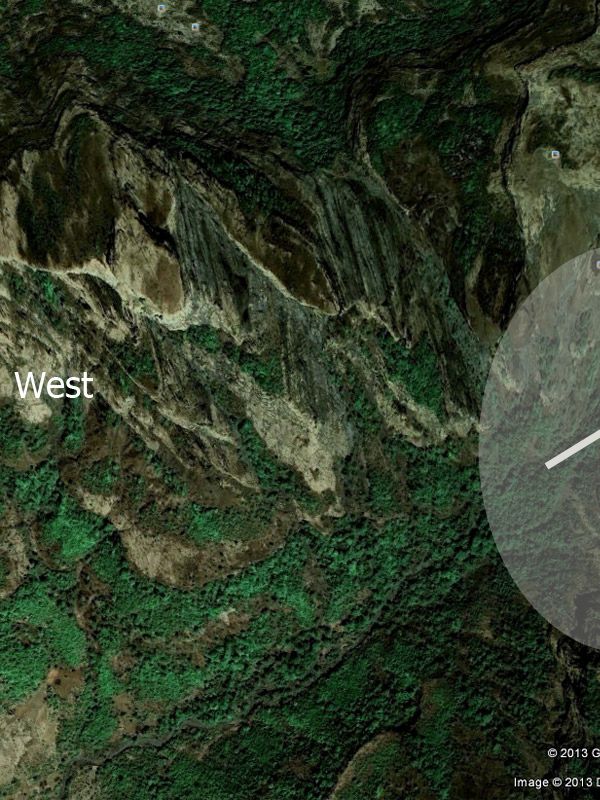 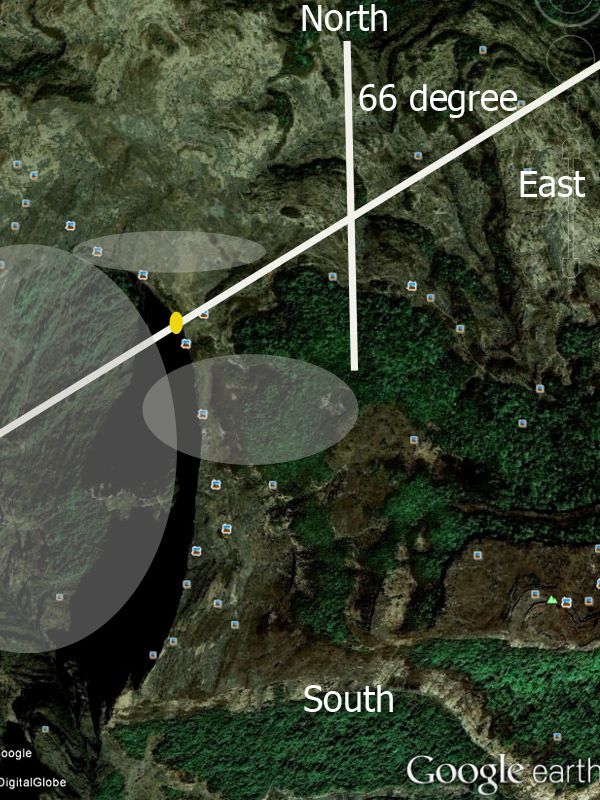 |
| |
| The Satellite image showing the sunrise angle and geography , Harishchandragad, North western ghats, India
|
| |
|
|
are clouds in valley and void on east in between viewer and sun. This is when for 15 to 30 seconds the Indravajra is seen. During this time depending on the intensity of sunlight, the intensity of colors of Indravajra vary. Due to dynamic distance between clouds and the viewer, the position of the Indravajra also changes. Sometimes it gets enlarged and sometimes it goes far off.
|
|
d) The size of the water drop in cloud decides the intensity of colors and visible bands. The number of bands visible also depends on opacity, distribution and size of particles. The contrast around helps one to see more circular bands.
|
|
|
| |
 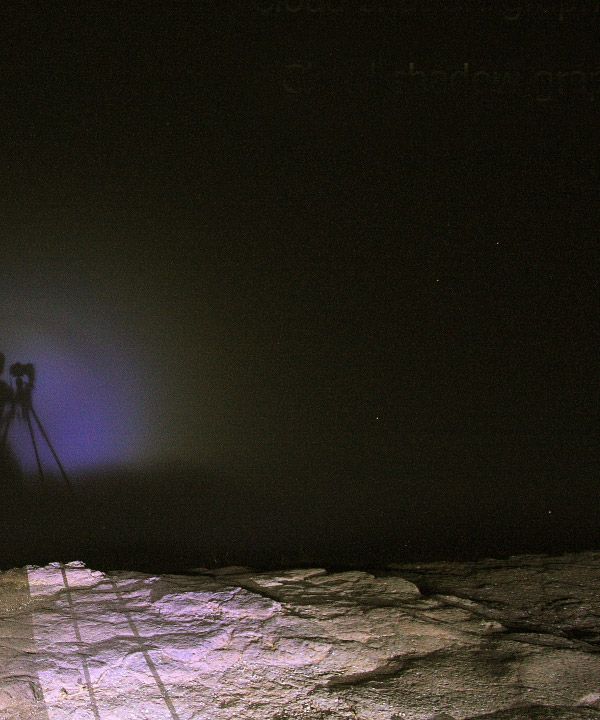 |
| |
| The Cloud shadowgraph using torch at night, Harishchandragad, North western ghats, India
|
| |
|
|
e) The simulation of this effect in night by using the torch is possible. However the shadow can be seen, corona can be seen. But the colored bands can not be seen, as it requires a light equivalent to sunlight.
|
|
f) During post monsoon season in early October, the sun rises at about 90 to 93 degree wrt North. This leads to the obstruction to sunlight due to Tararmati peak slope. To see the Indravajra in this season one has to go to the northern end of cliff or towards the Gaydara end near the Nalichi waat entry. Once can see nice Indravajra there with backdrop of Napta pinnacles.
|
|
|
| |
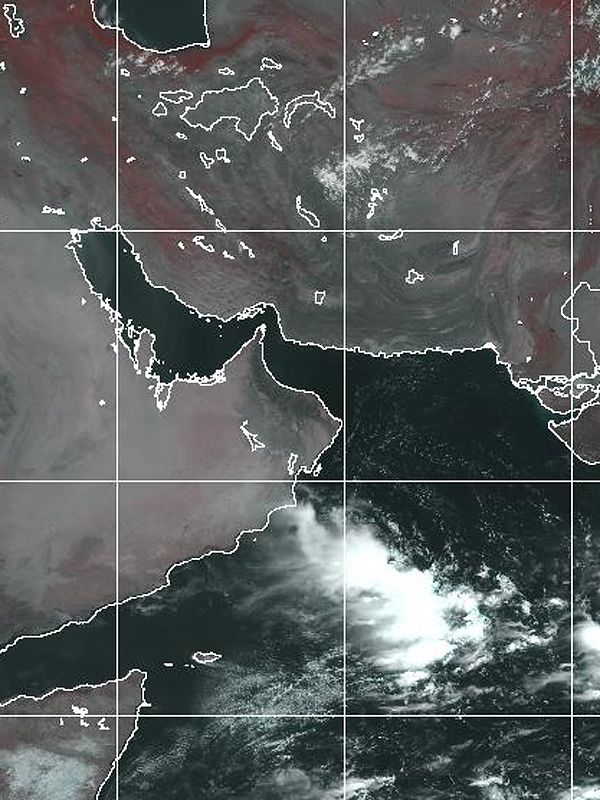 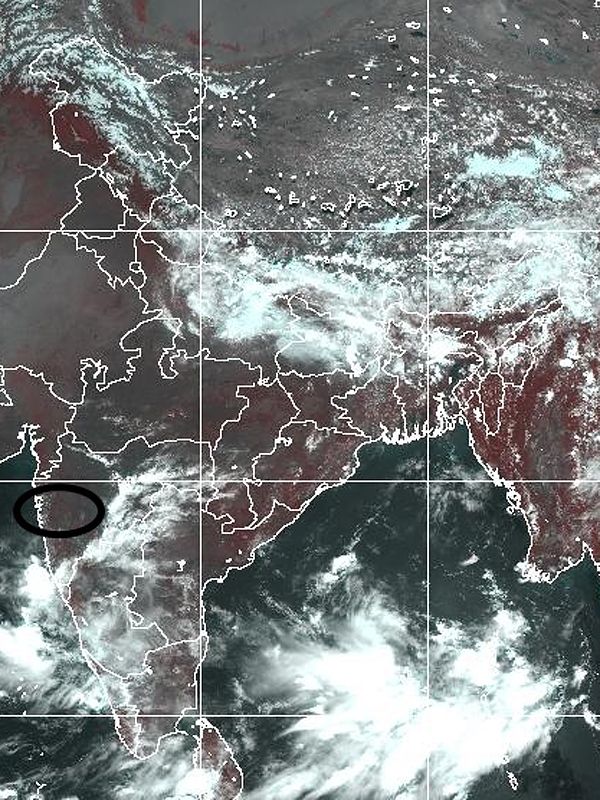 |
| |
| The Satellite image showing the clear weather on the day, Harishchandragad, North western ghats, India[ Special thanks to Santosh Subramanian for the image from IMD archives][ Special thanks to "vagaries of weather", a specialized group having amazing weather monitoring skills, for weather predictions]
|
| |
|
|
| |
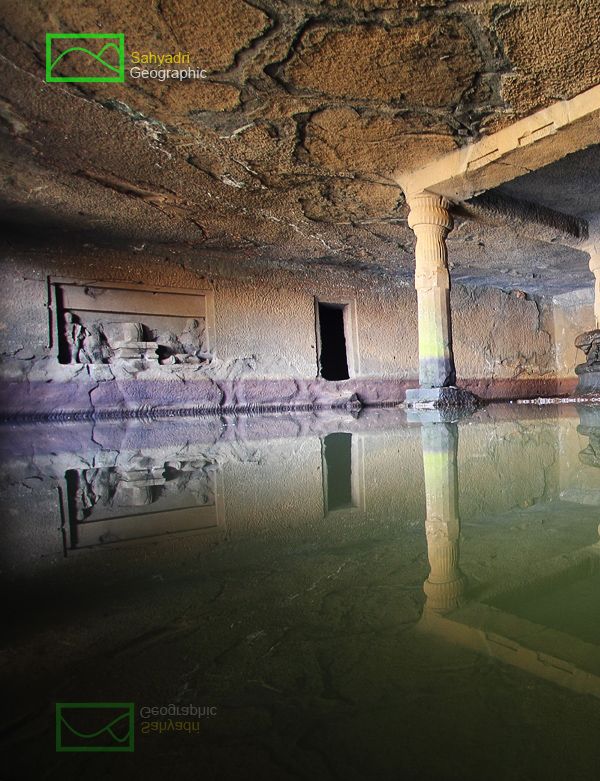 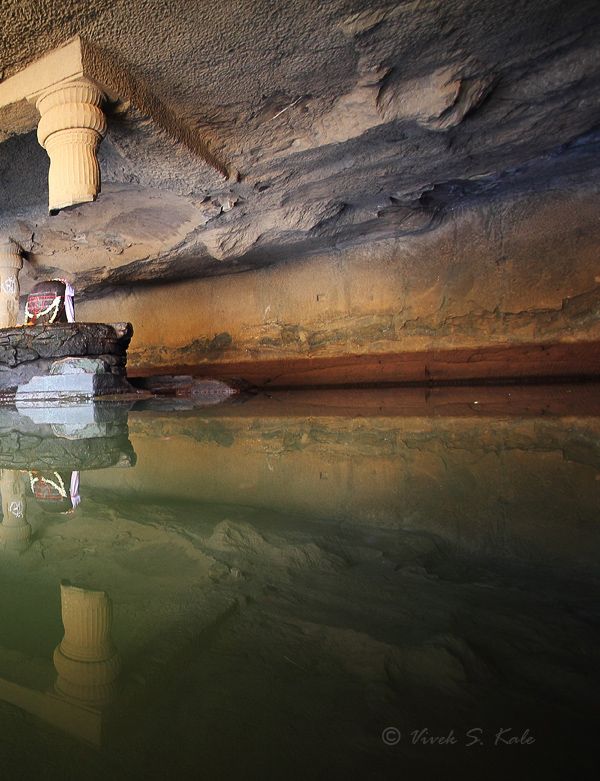 |
| |
| The Shiva Lingam, Harishchandragad, North western ghats, India
|
| |
|
|
| |
|








































